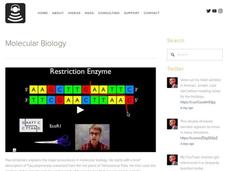Fuse School
Bronsted-Lowry Theory
Learn about the Arrhenius Theory as well as the holes in the theory with a video introduces the Bronsted-Lowry Theory and details the relationships with ions and protons.
Be Smart
How Bees Can See the Invisible
What do bees use to get rid of tangles? A honey-comb! The video focuses on how bees instinctively find flowers — their eyes view the world differently than ours. They also seem to be guided by electric charges because the bees have a...
Bozeman Science
Naming Compounds - Part 1
A movie critic would describe this resource as a bit formulaic, but that's what makes it work! The video explains the formula, or rules, for naming both covalent and ionic compounds.
Bozeman Science
Physical and Chemical Changes
What is more important, style or substance? This video explains the difference between physical (style) changes and chemical (substance) changes. It uses many examples and various ways of determining which type of change has occurred.
Bozeman Science
Properties of Matter
The properties of matter including buoyancy, viscosity, density, pressure, and more are explained in a video that also describes the various principles and laws that are associated with each property.
Fuse School
Strong and Weak Acids
Bring an informative resource to your unit on acids and bases with a video that explains strong and weak acids, pH scales, acids in solutions, dissociation, and dilution.
Fuse School
What Makes Something Acidic?
An informative video provides a definition for an acid, where it falls on the pH scale, and how individuals test for them. It uses many examples with chemical equations.
Bozeman Science
Thermoregulation
Hey, crank up the thermostat, my computer froze again! In a thermoregulation video, learners see how organisms either maintain their body temperatures or do not. The instructor explains the difference between conduction, convection,...
Bozeman Science
Homeostatic Loops
When someone is hot and their face is red, it is due to capillaries bringing blood closer to the surface of our skin so more heat can be lost. In the video, learners explore homeostasis and its role in the human body. Four homeostatic...
Bozeman Science
Anatomy and Physiology Introduction
Muscle tissue is three times more efficient at burning calories than fat. Here is a video that explores how form fits function, introducing anatomy and physiology. The instructor then explores homeostasis, hierarchy associated with...
Bozeman Science
Nervous System
The average adult human brain contains 100 billion neurons. In the video, scholars learn about brain lateralization and how different portions of our brain do different things. Learners then explore neurons, learning their parts and how...
Bozeman Science
Respiratory System
When at rest, humans exhale about 17.5 ml of water per hour, but they lose about four times that amount during exercise. The video shows learners how worms, insects, fish and humans all respire very differently. Viewers then explore the...
Bozeman Science
Reproductive System
The human reproductive system contains the largest (egg) and smallest (sperm) cells in the human body. It's time for scholars to review the differences between asexual and sexual reproduction. The instructor reminds them how meiosis...
Bozeman Science
Integumentary System
You will shed approximately 40 pounds of skin cells in your lifetime—wow! Scholars first learn about the multiple functions of our skin, both the epidermis and the dermis, and its role as a covering for the human body. The video then...
Bozeman Science
Immune System
Flu vaccines work by calling on the immune system to produce antibodies against the virus without actually infecting the individual with the flu. Here class members see how a virus enters cells and the body defends itself. The...
Bozeman Science
Three Domains of Life
Isn't a domain already a set of values, a territory, part of a web address, and an area of magnetism? In the last video, the instructor walks learners through a history of life on Earth. Scholars then see the seven characteristics of all...
Bozeman Science
Essential Characteristics of Life are Conserved
Humans' entire DNA sequence would fill two hundred 1,000-page telephone books. In the video, the instructor discusses the essential characteristics of all life - genetic code, the central dogma, and shared metabolic pathways. Scholars...
Bozeman Science
Homeostasis Hugs
Penguins, seals, and whales have countercurrent heat exchangers to limit blood flow in certain areas of their body, limiting their rate of heat loss to their environment. In this homeostasis video, the instructor explains that...
Bozeman Science
Sensory System
Humans can sense about 10,000 different odors. Young scientists explore how humans interpret the world around them using their senses. The instructor reminds learners of action potentials and the nervous system and then focuses on three...
Bozeman Science
Endocrine System
The pineal gland in the endocrine system secretes melatonin which helps humans sleep. In this human body video, scholars explore the major parts of the endocrine system. The instructor explains the roles of hormones, glands, and cells...
Fuse School
What Makes Things Alkali?
Begin with what an alkali is and how they are formed through ionic compounds. It discusses pH testing and the properties of bases. The video covers three different theories and the way they react.
Fuse School
Indicators
Use a scientific video that begins with types of pH indicators, including pH meters, universal indicators, and litmus paper to explain titration indicators.
Fuse School
What is the pH Scale
Seeing red? If it was blue litmus paper, then it is an acid. Viewers learn about the pH scale through a video that shows how liquids may be tested by litmus paper and a universal indicator.
Bozeman Science
Molecular Biology
Explore the bacteria at Yellowstone to introduce molecular biology. Scholars learn about the process of genetic engineering and how it has progressed over time, including the identification of the breast cancer genes and the main...























